Résultats de recherche de titre
Articles 1492501 à 1492520 sur 1499299
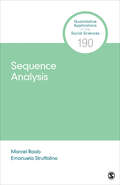
Sequence Analysis (Quantitative Applications in the Social Sciences)
Par Marcel Raab, Emanuela Struffolino. 2023
Sequence analysis (SA) was developed to study social processes that unfold over time as sequences of events. It has gained…
increasing attention as the availability of longitudinal data made it possible to address sequence-oriented questions. This volume introduces the basics of SA to guide practitioners and support instructors through the basic workflow of sequence analysis. In addition to the basics, this book outlines recent advances and innovations in SA. The presentation of statistical, substantive, and theoretical foundations is enriched by examples to help the reader understand the repercussions of specific analytical choices. The extensive ancillary material supports self-learning based on real-world survey data and research questions from the field of life course research. Data and code and a variety of additional resources to enrich the use of this book are available on an accompanying website.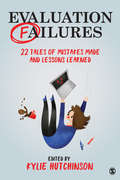
Evaluation Failures: 22 Tales of Mistakes Made and Lessons Learned
Par Kylie Hutchinson. 2019
"This is the evaluation book we′ve been waiting for! A must-read for all learning and working in the field." –Amanda…
M. Olejarski, West Chester University Evaluation Failures: 22 Tales of Mistakes Made and Lessons Learned is a candid collection of stories from seasoned evaluators from a variety of sectors sharing professional mistakes they have made in the past, and what they learned moving forward. As the only book of its kind, editor Kylie Hutchinson has collected a series of engaging, real-life examples that are both entertaining and informative. Each story offers universal lessons as takeaways, and discussion questions for reflective practice. The book is the perfect companion to anyone working in the evaluation field, and to instructors of program evaluation courses who want to bring the real world into their classroom.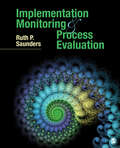
Implementation Monitoring and Process Evaluation
Par Ruth P. Saunders. 2016
This practical guide helps readers understand and use the steps that program planners and evaluators take in implementing and monitoring…
a new program, policy, or practice in an organizational setting. The book covers the entire process, from planning, to carrying out the plan, and summarizing, reporting, and using the results. A wide range of real-world examples in the book are drawn from health, education, non-profit organizations, and public administration, and an extended case study, Your Turn boxes, and worksheet templates help readers apply concepts to their own projects. Ideal for practitioners, researchers, and students, this book can be used as a primary text for a process evaluation or an implementation monitoring course or as a supplemental text in a broader program evaluation course.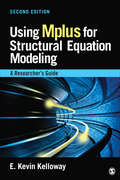
Using Mplus for Structural Equation Modeling: A Researcher′s Guide
Par E Kelloway. 2015
Ideal for researchers and graduate students in the social sciences who require knowledge of structural equation modeling techniques to answer…
substantive research questions, Using Mplus for Structural Equation Modeling provides a reader-friendly introduction to the major types of structural equation models implemented in the Mplus framework. This practical book, which updates author E. Kevin Kelloway’s 1998 book Using LISREL for Structural Equation Modeling, retains the successful five-step process employed in the earlier book, with a thorough update for use in the Mplus environment. Kelloway provides an overview of structural equation modeling techniques in Mplus, including the estimation of confirmatory factor analysis and observed variable path analysis. He also covers multilevel modeling for hypothesis testing in real life settings and offers an introduction to the extended capabilities of Mplus, such as exploratory structural equation modeling and estimation and testing of mediated relationships. A sample application with the source code, printout, and results is presented for each type of analysis.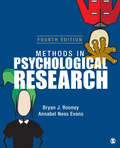
Methods in Psychological Research
Par Annabel Ness Evans, Bryan J. Rooney. 2019
Methods in Psychological Research introduces students to the rich world of research in psychology through student-friendly writing, compelling real-world examples,…
and frequent opportunities for practice. Using a relaxed yet supportive tone that eases student anxiety, the authors present a mixture of conceptual and practical discussions, and spark reader interest in research by covering meaningful topics that resonate with today’s students. In-text features like Conceptual Exercises, FYI sections, and FAQ sections with accompanying visual cues support learning throughout the research experience. The Fourth Edition equips students with the tools they need to understand research concepts, conduct their own experiments, and present their findings.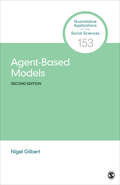
Agent-based simulation has become increasingly popular as a modeling approach in the social sciences because it enables researchers to build…
models where individual entities and their interactions are directly represented. The Second Edition of Nigel Gilbert′s Agent-Based Models introduces this technique; considers a range of methodological and theoretical issues; shows how to design an agent-based model, with a simple example; offers some practical advice about developing, verifying and validating agent-based models; and finally discusses how to plan an agent-based modelling project, publish the results and apply agent-based modeling to formulate and evaluate social and economic policies.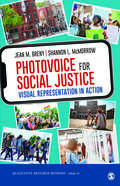
Photovoice for Social Justice: Visual Representation in Action (Qualitative Research Methods)
Par Jean M. Breny, Shannon L. McMorrow. 2021
Photovoice for Social Justice, the latest volume in SAGE′s Qualitative Research Methods Series, helps readers in the health and social sciences learn…
the foundations and applications of this exciting qualitative method. Authors Jean M. Breny and Shannon L. McMorrow approach photovoice as not only a community-based participatory research method, but as a method for social justice, centering community participants, organizations, and policy makers at the heart of this research method. Special topics relating to social justice include a focus on ethics and working with marginalized communities, sensitive concerns during data collection, and presenting the work to communities and policymakers, as well as academics. Written for students and researchers new to photovoice, this brief text takes readers from the process of conceptualizing and implementing a photovoice study to analyzing data and finally presenting the results of the study. The book concludes with suggestions for future iterations of photovoice, including web based resources and digital storytelling. The authors take into account the realities of photovoice as a method by providing practical, applied tools including sample consent forms, presentations, recruitment flyers, and photo-taking tips. Using Photovoice for Social Justice, new and experienced researchers can design, implement, and analyze their photovoice projects.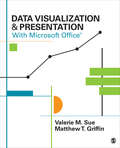
Data Visualization & Presentation With Microsoft Office
Par Valerie M. Sue, Matthew T. Griffin. 2016
Written for students, professionals, and social scientists with little or no knowledge of data visualization principles, this complete guide presents…
step-by-step instructions for clearly and effectively presenting data using MS Office programs. Throughout the book, the focus is on turning raw, quantitative data into attractive, well-designed charts and tables that tell an accurate narrative about underlying information. Helpful illustrations, expert tips for solving common issues, and discussions on working efficiently are included to equip readers with the tools they need to engage their audience using a visual format.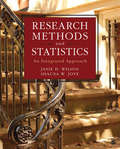
Research Methods and Statistics: An Integrated Approach
Par Janie H. Wilson, Shauna W. Joye. 2017
This innovative text offers a completely integrated approach to teaching research methods and statistics by presenting a research question accompanied…
by the appropriate methods and statistical procedures needed to address it. Research questions and designs become more complex as chapters progress, building on simpler questions to reinforce student learning. Using a conversational style and research examples from published works, this comprehensive book walks readers through the entire research process and includes ample pedagogical support for SPSS, Excel, and APA style.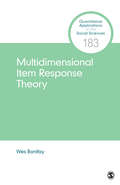
Several decades of psychometric research have led to the development of sophisticated models for multidimensional test data, and in recent…
years, multidimensional item response theory (MIRT) has become a burgeoning topic in psychological and educational measurement. Considered a cutting-edge statistical technique, the methodology underlying MIRT can be complex, and therefore doesn’t receive much attention in introductory IRT courses. However author Wes Bonifay shows how MIRT can be understood and applied by anyone with a firm grounding in unidimensional IRT modeling. His volume includes practical examples and illustrations, along with numerous figures and diagrams. Multidimensional Item Response Theory includes snippets of R code interspersed throughout the text (with the complete R code included on an accompanying website) to guide readers in exploring MIRT models, estimating the model parameters, generating plots, and implementing the various procedures and applications discussed throughout the book.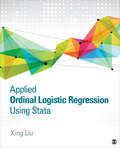
The first book to provide a unified framework for both single-level and multilevel modeling of ordinal categorical data, Applied Ordinal…
Logistic Regression Using Stata helps readers learn how to conduct analyses, interpret the results from Stata output, and present those results in scholarly writing. Using step-by-step instructions, this non-technical, applied book leads students, applied researchers, and practitioners to a deeper understanding of statistical concepts by closely connecting the underlying theories of models with the application of real-world data using statistical software. An open-access website for the book contains data sets, Stata code, and answers to in-text questions.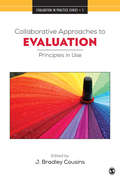
Collaborative Approaches to Evaluation: Principles in Use (Evaluation in Practice Series #3)
Par J. Bradley Cousins. 2020
Editor J. Bradley Cousins and colleagues meet the needs of evaluators seeking to implement collaborative and participatory approaches to evaluation…
in Collaborative Approaches to Evaluation: Principles in Use. Using a multi-phase empirical process to develop and validate a set of principles to guide collaborative approaches to evaluation, the book outlines the principles that the team developed, and then provides case studies of how these principles have been applied in practice. The case studies draw on programs globally in education, health, and community development. The book is an invaluable supplementary text for program evaluation courses where students’ projects are focused on more collaborative and participatory approaches, and it is an essential resource for practicing evaluators and those who commission program evaluations.
How To Do Research: 15 Labs for the Social & Behavioral Sciences
Par Jane F. Gaultney, Hannah D. Peach. 2016
Designed to help students make the leap from learning about research to doing research, this manual provides an easy-to-understand walkthrough…
of the entire research process, from selecting a topic and conducting a literature review through presenting an APA-style paper or presentation. All of the 15 cross-disciplinary labs included are appropriate for use in the social, behavioral, and health sciences, and follow a consistent format: objective, description of a journal article, canned data, examples of what output should look like, pointers on interpreting the output, and a suggested activity for those who wish to collect their own data.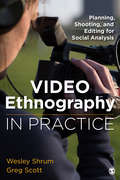
Video Ethnography in Practice: Planning, Shooting, and Editing for Social Analysis
Par Wesley M. Shrum, Gregory S. Scott. 2017
Video Ethnography in Practice is a brief guide for students in the social disciplines who are required to produce an…
ethnographic video, the most significant new methodological technique in 21st century social analysis. The authors, both accomplished videographers, cover the basic techniques of creating a video that documents human culture and behavior with true stories of the process of videography throughout. This text shows how new technologies like smart phones, widely available video editing software, and YouTube, have turned video ethnography into something that is within reach of students in a conventional course framework.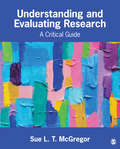
Understanding and Evaluating Research: A Critical Guide
Par Sue L. McGregor. 2018
Understanding and Evaluating Research: A Critical Guide shows students how to be critical consumers of research and to appreciate the…
power of methodology as it shapes the research question, the use of theory in the study, the methods used, and how the outcomes are reported. The book starts with what it means to be a critical and uncritical reader of research, followed by a detailed chapter on methodology, and then proceeds to a discussion of each component of a research article as it is informed by the methodology. The book encourages readers to select an article from their discipline, learning along the way how to assess each component of the article and come to a judgment of its rigor or quality as a scholarly report.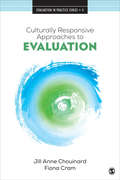
Culturally Responsive Approaches to Evaluation: Empirical Implications for Theory and Practice (Evaluation in Practice Series #4)
Par Fiona Cram, Jill Chouinard. 2020
Evaluators have always worked in diverse communities, and the programs they evaluate are designed to address often intractable socio-political and…
economic issues. Evaluations that explicitly aim to be more responsive to culture and cultural context are, however, a more recent phenomenon. In this book, Jill Anne Chouinard and Fiona Cram utilize a conceptual framework that foregrounds culture in social inquiry, and then uses that framework to analyze empirical studies across three distinct cultural domains of evaluation practice (Western, Indigenous and international development). Culturally Responsive Approaches to Evaluation provide a comparative analysis of these studies and discuss lessons drawn from them in order to help evaluators extend their current thinking and practice. They conclude with an agenda for future research.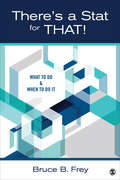
There′s a Stat for That!: What to Do & When to Do it
Par Bruce B. Frey. 2016
Bruce Frey’s There’s a Stat for That! is a brief, straightforward, and to-the-point guide to deciding which statistical analysis to…
use and when to use it. Designed for consultants, researchers, students, and those who already have the resources to tell them how to perform the analyses, this text explains why a particular statistical approach is the right one to use. The book affirms that regardless of the group design, once the variables are chosen and the measurement strategy is worked out, one can rest assured that there is a stat for that!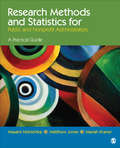
Research Methods and Statistics for Public and Nonprofit Administrators: A Practical Guide
Par Masami Nishishiba, Mariah A. Kraner, Matthew A. Jones. 2014
"The approach is well executed. The problems encountered by [the characters] represent real-life issues than administrators are faced with and…
the applications needed to address them." —Lee W. Payne, Stephen F. Austin State University Research Methods and Statistics for Public and Nonprofit Administrators: A Practical Guide is a comprehensive, easy-to-read, core text that thoroughly prepares readers to apply research methods and data analysis to the professional environments of public and non-profit administration. The authors expertly incorporate original case examples to demonstrate concepts using "real actors," facing specific scenarios, in which research methods must be applied. This unique approach—presented in language accessible to both students new to research as well as current practitioners—guides the reader in fully understanding the research options detailed throughout the text.
Using Mplus for Structural Equation Modeling: A Researcher′s Guide
Par E Kelloway. 2015
Ideal for researchers and graduate students in the social sciences who require knowledge of structural equation modeling techniques to answer…
substantive research questions, Using Mplus for Structural Equation Modeling provides a reader-friendly introduction to the major types of structural equation models implemented in the Mplus framework. This practical book, which updates author E. Kevin Kelloway’s 1998 book Using LISREL for Structural Equation Modeling, retains the successful five-step process employed in the earlier book, with a thorough update for use in the Mplus environment. Kelloway provides an overview of structural equation modeling techniques in Mplus, including the estimation of confirmatory factor analysis and observed variable path analysis. He also covers multilevel modeling for hypothesis testing in real life settings and offers an introduction to the extended capabilities of Mplus, such as exploratory structural equation modeling and estimation and testing of mediated relationships. A sample application with the source code, printout, and results is presented for each type of analysis.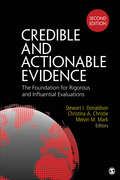
Credible and Actionable Evidence: The Foundation for Rigorous and Influential Evaluations
Par Stewart I. Donaldson, Melvin M. Mark, Christina A. Christie. 2015
Addressing one of the most important and contentious issues challenging applied research and evaluation practice today—what constitutes credible and actionable…
evidence?—this volume offers a balanced and current context in which to analyze the long-debated quantitative-qualitative paradigms. In the Second Edition, the contributors, a veritable "who’s who" in evaluation, discuss the diversity and changing nature of credible and actionable evidence; offer authoritative guidance about using credible and actionable evidence; explain how to use it to provide rigorous and influential evaluations; and include lessons from their own applied research and evaluation to suggest ways to address the key issues and challenges. Reflecting the latest developments in the field and covering both experimental and non-experimental methods, the new edition includes revised and updated chapters, summaries of strengths and weaknesses across varied approaches, and contains diverse definitions of evidence. Also included are two new chapters on assessing credibility and synthesizing evidence for policy makers. This is a valuable resource for students and others interested in how to best study and evaluate programs, policies, organizations, and other initiatives designed to improve aspects of the human condition and societal well-being.